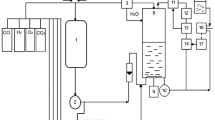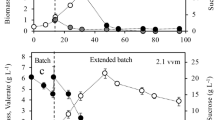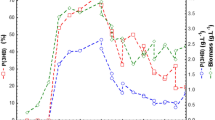Abstract
The recovery of poly(3-hydroxybutyrate) [PHB] fromAlcaligenes eutrophus and a recombinantEscherichia coli strain harboring theA. eutrophus poly(3-hydroxyalkanoates) biosynthesis genes was studied. When PHB was recovered using sodium hypochlorite or sodium dodecyl sulfate (SDS), non-PHB cell materials (NPCM) of the recombinantE. coli seemed to be more easily digested than those ofA. eutrophus. Furthermore, viscosity increase caused by cell lysis during SDS treatment was negligible for the recombinantE. coli, whereas a very viscous suspension was formed forA. eutrophus. These results, together with our previous finding that PHB in the recombinantE. coli is far less susceptible to molecular degradation by sodium hypochlorite, suggested that the recombinantE. coli was more beneficial than A.eutrophus in terms of PHB recovery. In order to develop an easy and efficient recovery process, we adopted and optimized the SDS treatment since, with the hypochlorite treatment, we could not handle high biomass concentrations effectively. We could obtain a PHB of 95 % purity with 96 % recovery under the optimal condition of a biomass concentration of 5 %, a ratio of SDS to biomass of 0.6, a treatment time of 60 minutes, and a treatment temperature of 30°C.
Similar content being viewed by others
References
Barham, P. G., Keller, A., Otum, E. L. and Holmes, P. A., “Crystallization and Morphology of a Bacterial Thermoplastic: Poly-Β-hydroxybutyrate”,J. Mater. Sci.,19, 2781 (1984).
Berger, E., Ramsay, B. A., Ramsay, J. A., Chavarie, C. and Braunegg, G., “PHB Recovery by Hypochlorite Digestion of Non-PHB Biomass”,Biotechnol. Techniques,3, 227 (1989).
Braunegg, G., Sonnleitner, B. and Lafferty, R. M., “A Rapid Gas Chromatographic Method for the Determination of Poly-Β-hydroxybutyric Acid in Microbial Biomass”,Eur. J. Appl Microbiol. Biotechnol.,6, 29 (1978).
Byrom, D., “Polymer Synthesis by Microorganisms: Technology and Economics”,Trends in Biotechnol,5, 246 (1987).
Hahn, S. K., Chang, Y. K., Kim, B. S., Lee, K. M. and Chang, H. N., The Recovery of Poly(3-hydroxybutyrate) by Using Dispersions of Sodium Hypochlorite Solution and Chloroform”,Biotechnol. Techniques,7, 209 (1993).
Hahn, S. K., Chang, Y. K. and Lee, S. Y., “Recovery and Characterization of Poly(3-hydroxybutyric acid) Synthesized inAlcaligenes eutrophus and RecombinantEscherichia coli”,Appl. Environ. Microbiol,61, 34 (1995).
Holmes, P. A, “Applications of PHB-A Microbially Produced Biodegradable Thermoplastic”,Phys. Technol,16, 32 (1985).
Hohnes, P. A. and Lim, G. B., “Separation Process”, U.S. Patent 4910145, 1990.
Kim, B. S, Cho, G. D, Oh, J. T. and Kim, W. S, “The Effects of Alcohols in Substrate on the Biosynthesis of PHB and P (HB-co-HV)”,HWAHAK KONGHAK,32(3), 441 (1994).
Kim, B. S., Lee, S. C., Lee, S. Y., Chang, H. N., Chang, Y. K. and Woo, S. I., “Production of Poly(3-hydroxybutyric acid) by Fed-Batch Culture ofAlcaligenes eutrophus with Glucose Concentration Control”,Biotechnol. Bioeng.,43, 892 (1994).
Koo, Y. M, Parekh, B. S., Hatfield, G. W. and Lim, H. C., “Controlled Lysis ofEscherichia coli Double-Lysogen of Bacteriophage λHL1 and Φ434”,Korean J. Chem. Eng,13(2), 202 (1996).
Lafferty, R. M. and Heinzle, E., “Use of Cyclic Carbonic Acid Esters as Solvents for Poly(Β-hydroxybutyric Acid)”, U.S. Patent 868795, 1979.
Lee, S. Y., Chang, H. N. and Chang, Y. K., “Production of Poly(Β-hydroxybutyric acid) by RecombinantEscherichia coli”, Ann. NY Acad. Sci,721, 43 (1994b).
Lee, S. Y., Lee, K. M., Chang, H. N. and Steinbüchel, A., “Comparison of RecombinantEscherichia coli Strains for Synthesis and Accumulation of Poly(3-hydroxybutyric acid) and Morphological Changes”,Biotechnol Bioeng.,44, 1337 (1995).
Lee, S. Y., Yim, K. S., Chang, H. N. and Chang, Y. K., “Construction of Plasmids, Eestimarion of Plasmid Stability, and Use of Stable Plasmids for the Production of Poly(3-hydroxybutyric acid) by Recombinant Escherichia coli”,J. Biotechnol,32, 203 (1994a).
Mayer, J. M. and Kaplan, D. L., “Biodegradable Materials: Balancing Degradability and Performance”,Trends in Biotechnol,2, 227 (1994).
Middelberg, A. P. J., Lee, S. Y., Martin, J., Williams, D. R. G. and Chang, H. N., “Size Analysis of Poly(3-hydroxybutyric acid) Granules Produced in RecombinantEscherichia coli”,Biotechnol Lett.,17, 205 (1995).
Page, W. J. and Cornish, A, “Growth ofAzotobacter vinelandii UWD in Fish Peptone Medium and Simplified Extraction of Poly-Β-hydroxybutyrate”,Appl. Environ. Microbiol,59, 4236 (1993).
Poirier, Y., Nawrath, C. and Somerville, C., “Production of Polyhydroxyalkanoates, A Family of Biodegradable Plastics and Elastomers, in Bacteria and Plants”,Biotechnol,13, 142 (1995).
Ramsay, J. A., Berger, E., Ramsay, B. A. and Chavarie, C., “Recovery of Poly-Β-hydroxybutyric Acid Granules by a Surfactant-hypochlorite Treatment”,Biotechnol Techniques,4, 221 (1990).
Swift, G., “Directions for Environmentally Biodegradable Polymer Research”,Acc. Chem. Res.,26, 105 (1993).
Yim, K. S., Lee, S. Y. and Chang, H. N., “Effect of Acetic Acid on Poly(3-Hydroxybutyrate-co-hydroxyvalerate) Synthesis in RecombinantEscherichia coli”,Korean J. Chem. Eng.,12(2), 264 (1995).
Author information
Authors and Affiliations
Corresponding author
Rights and permissions
About this article
Cite this article
Hahn, S.K., Ryu, H.W. & Chang, Y.K. Comparison and optimization of poly(3-hydroxybutyrate) recovery fromAlcaligenes eutrophus and recombinantEscherichia coli . Korean J. Chem. Eng. 15, 51–55 (1998). https://doi.org/10.1007/BF02705305
Received:
Accepted:
Issue Date:
DOI: https://doi.org/10.1007/BF02705305




